Potential Source Contribution Function Analysis of High Latitude Dust Sources over the Arctic: Preliminary Results and Prospects
Abstract
:1. Introduction
2. Materials and Methods
2.1. Aerosol Samples
2.2. Chemical Analyses
2.3. Air Mass Back Trajectories
2.4. Potential Source Contribution Function Analysis
3. Results and Discussion
3.1. Dust Sources and Dust Events
3.2. Geochemical Pattern of the Source Regions
3.3. Properties and Long-Range Transport of Icelandic Dust
3.3.1. Mixing Processes
3.3.2. Emission and Transport Processes
4. Conclusions
Author Contributions
Funding
Institutional Review Board Statement
Informed Consent Statement
Data Availability Statement
Acknowledgments
Conflicts of Interest
References
- Serreze, M.C.; Francis, J.A. The arctic amplification debate. Clim. Chang. 2006, 76, 241–264. [Google Scholar] [CrossRef] [Green Version]
- Lambert, F.; Kug, J.-S.; Park, R.J.; Mahowald, N.; Winckler, G.; Abe- Ouchi, A.; O’Ishi, R.; Takemura, T.; Lee, J.H. The role of mineral-dust aerosols in polar temperature amplification. Nat. Clim. Chang. 2013, 3, 487–491. [Google Scholar] [CrossRef]
- Boy, M.; Thomson, E.S.; Acosta Navarro, J.-C.; Arnalds, O.; Batchvarova, E.; Bäck, J.; Berninger, F.; Bilde, M.; Brasseur, Z.; Dagsson-Waldhauserova, P.; et al. Interactions between the atmosphere, cryosphere, and ecosystems at northern high latitudes. Atmos. Chem. Phys. 2019, 19, 2015–2061. [Google Scholar] [CrossRef] [Green Version]
- Dagsson-Waldhauserova, P.; Meinander, O. Editorial: Atmosphere—Cryosphere interaction in the Arctic, at High Latitudes and mountains with focus on transport, deposition, and effects of dust, black carbon, and other aerosols. Front. Earth Sci. 2019, 7, 337. [Google Scholar] [CrossRef] [Green Version]
- Kylling, A.; Groot Zwaaftink, C.D.; Stohl, A. Mineral dust instantaneous radiative forcing in the Arctic. Geophys. Res. Lett. 2018. [Google Scholar] [CrossRef] [Green Version]
- Saidou Chaibou, A.A.; Ma, X.; Sha, T. Dust radiative forcing and its impact on surface energy budget over West Africa. Sci. Rep. 2020, 10, 12236. [Google Scholar] [CrossRef] [PubMed]
- Groot Zwaaftink, C.D.; Arnalds, O.; Dagsson-Waldhauserova, P.; Eckhardt, S.; Prospero, J.M.; Stohl, A. Temporal and spatial variability of Icelandic dust emission and atmospheric transport. Atmos. Chem. Phys. 2017, 17, 10865–10878. [Google Scholar] [CrossRef] [Green Version]
- Groot Zwaaftink, C.D.; Grythe, H.; Skov, H.; Stohl, A. Substantial contribution of northern high-latitude sources to mineral dust in the Arctic. J. Geophys. Res. Atmos. 2016, 121, 13678–13697. [Google Scholar] [CrossRef]
- Baddock, M.C.; Mockford, T.; Bullard, J.E.; Thorsteinsson, T. Pathways of high-latitude dust in the North Atlantic. Earth Planet. Sc. Lett. 2017, 459, 170–182. [Google Scholar] [CrossRef] [Green Version]
- Zhang, X.L.; Wu, G.J.; Zhang, C.L.; Xu, T.L.; Zhou, Q.Q. What is the real role of iron oxides in the optical properties of dust aerosols? Atmos. Chem. Phys. 2015, 15, 12159–12177. [Google Scholar] [CrossRef] [Green Version]
- Bullard, J.E.; Baddock, M.; Bradwell, T.; Crusius, J.; Darlington, E.; Gaiero, D.; Gassó, S.; Gisladdottir, G.; Hodgkins, R.; McCulloch, R.; et al. High-latitude dust in the earth system. Rev. Geophys. 2016, 54, 447–485. [Google Scholar] [CrossRef] [Green Version]
- Baratoux, D.; Mangold, N.; Arnalds, O.; Bardintzeff, J.-M.; Platevoët, B.; Grégoire, M.; Pinet, P. Volcanic sands of Iceland–diverse origins of aeolian sand deposits revealed at Dyngjusandur and Lambahraun. Earth Surf. Proc. Land. 2011, 36, 1789–1808. [Google Scholar] [CrossRef]
- Arnalds, O.; Dagsson-Waldhauserova, P.; Olafsson, H. The Icelandic volcanic aeolian environment: Processes and impacts—A review. Aeolian Res. 2016, 20, 176–195. [Google Scholar] [CrossRef] [Green Version]
- Sanchez-Marroquin, A.; Arnalds, O.; Baustian-Dorsi, K.J.; Browse, J.; Dagsson-Waldhauserova, P.; Harrison, A.D.; Maters, E.C.; Pringle, K.J.; Vergara-Temprado, J.; Burke, I.T.; et al. Iceland is an episodic source of atmospheric ice-nucleating particles relevant for mixed-phase clouds. Sci. Adv. 2020, 6. [Google Scholar] [CrossRef] [PubMed]
- Baldo, C.; Formenti, P.; Nowak, S.; Chevaillier, S.; Cazaunau, M.; Pangui, E.; Di Biagio, C.; Doussin, J.-F.; Ignatyev, K.; Dagsson Waldhauserova, P.; et al. Distinct chemical and mineralogical composition of Icelandic dust compared to North African and Asian dust. Atmos. Chem. Phys. 2020, 20, 1–19. [Google Scholar] [CrossRef]
- Moroni, B.; Arnalds, O.; Dagsson-Waldhauserova, P.; Rocchianti, S.; Vivani, R.; Cappelletti, D. Mineralogical and chemical records of Icelandic dust sources upon Ny-Ålesund (Svalbard Islands). Front. Earth Sci. 2018. [Google Scholar] [CrossRef]
- Ashbaugh, L.; Malm, W.; Sadeh, W. A residence time probability analysis of sulfur concentrations at Grand Canyon National Park. Atmos. Environ. 1985, 19, 1263–1270. [Google Scholar] [CrossRef]
- Petroselli, C.; Crocchianti, S.; Moroni, B.; Castellini, S.; Selvaggi, R.; Nava, S.; Calzolai, G.; Lucarelli, F.; Cappelletti, D. Disentangling the major source areas for an intense aerosol advection in the Central Mediterranean on the basis of potential source contribution function modeling of chemical and size distribution measurements. Atmos. Res. 2018, 204, 67–77. [Google Scholar] [CrossRef]
- Moroni, B.; Crocchianti, S.; Petroselli, C.; Selvaggi, R.; Becagli, S.; Traversi, R.; Cappelletti, D. Potential source contribution function analysis of long-range transported aerosols in the Central Mediterranean: A comparative study of two background sites in Italy. Rend. Fis. Acc. Lincei 2019. [Google Scholar] [CrossRef]
- Cappelletti, D.; Azzolini, R.; Langone, L.; Ventura, S.; Viola, A.; Aliani, S.; Vitale, V.; Brugnoli, E. Environmental changes in the Arctic: An Italian perspective. Rend. Lincei 2016, 27, 1–6. [Google Scholar] [CrossRef]
- Giardi, F.; Traversi, R.; Becagli, S.; Severi, M.; Caiazzo, L.; Ancillotti, C.; Udisti, R. Inductively Coupled Plasma Mass Spectrometry with desolvation nebulizer inlet system. Sci. Total Environ. 2017, 613–614, 1284–1294. [Google Scholar]
- Udisti, R.; Bazzano, A.; Becagli, S.; Bolzacchini, E.; Caiazzo, L.; Cappelletti, D.; Ferrero, L.; Frosini, D.; Giardi, F.; Grotti, M.; et al. Sulfate source apportionment in the Ny-Ålesund (Svalbard Islands) Arctic aerosol. Rend. Lincei 2016, 27, 85–94. [Google Scholar] [CrossRef]
- Giardi, F.; Becagli, S.; Traversi, R.; Frosini, D.; Severi, M.; Caiazzo, L.; Ancillotti, C.; Cappelletti, D.; Moroni, B.; Grotti, M.; et al. Size distribution and ion composition of aerosol collected at Ny-Ålesund in the springesummer field campaign 2013. Rend. Lincei 2016, 27. [Google Scholar] [CrossRef] [Green Version]
- Draxler, R.R.; Rolph, G.D. HYSPLIT (Hybrid Single-Particle Lagrangian Integrated Trajectory) Model; NOAA Air Resources Laboratory: Silver Spring, MD, USA, 2003.
- Schuetz, L. Atmospheric Mineral Dust-Properties and Source Markers. In Paleoclimatology and Paleometeorology: Modern and Past Patterns of Global Atmospheric Transport. NATO ASI Series (Series C: Mathematical and Physical Sciences); Leinen, M., Sarnthein, M., Eds.; Springer: Dordrecht, The Netherlands, 1989; Volume 282. [Google Scholar] [CrossRef]
- Shelley, R.U.; Roca-Martí, M.; Castrillejo, M.; Masqué, P.; Landing, W.M.; Planquette, H.; Sarthou, G. Quantification of trace element atmospheric deposition fluxes tothe Atlantic Ocean (>40°N.; GEOVIDE, GEOTRACES GA01) during spring 2014. Deep-Sea Res. I Oceanogr. Res. Pap. 2017, 119, 34–49. [Google Scholar] [CrossRef] [Green Version]
- Taylor, S.R. Abundance of chemical elements in the continental crust: A new table. Geochim. Cosmochim. Acta 1964, 28, 1273–1285. [Google Scholar] [CrossRef]
- Brookshaw, D.R.; Coker, V.S.; Lloyd, J.R.; Vaughan, D.J.; Pattrick, R.A. Redox interactions between Cr(VI) and Fe(II) in bioreduced biotite and chlorite. Environ. Sci. Technol. 2014, 48, 11337–11342. [Google Scholar] [CrossRef]
- Gieseking, J.E. Soil Components: Volume 2: Inorganic Components; Springer: New York, NY, USA, 1975; 683p. [Google Scholar]
- Fekiacova, Z.; Cornu, S.; Pichat, S. Tracing contamination sources in soils with Cu and Zn isotopic ratios. Sci. Total Environ. 2015, 517, 96–105. [Google Scholar] [CrossRef] [Green Version]
- Eckhardt, S.; Stohl, A.; Beirle, S.; Spichtinger, N.; James, P.; Forster, C.; Junker, C.; Wagner, T.; Platt, U.; Jennings, S.G. The North Atlantic Oscillation controls air pollution transport to the Arctic. Atmos. Chem. Phys. Discuss. 2003, 3, 3222–3240. [Google Scholar]
- Stohl, A. Characteristics of atmospheric transport into the arctic troposphere. J. Geophy. Res. Atmos. 2006, 111, D11306. [Google Scholar] [CrossRef]
- Moroni, B.; Cappelletti, D.; Crocchianti, S.; Becagli, S.; Caiazzo, L.; Traversi, R.; Udisti, R.; Mazzola, M.; Markowicz, K.; Ritter, C.; et al. Morphochemical characteristics and mixing state of long range transported wildfire particles at Ny-Ålesund (Svalbard Islands). Atmos. Environ. 2017, 156, 135–145. [Google Scholar] [CrossRef]
- Moroni, B.; Ritter, C.; Crocchianti, S.; Markowicz, K.; Mazzola, M.; Becagli, S.; Traversi, R.; Krejci, R.; Tunved, P.; Cappelletti, D. Individual Particle characteristics, optical properties and evolution of an extreme long-range transported biomass burning event in the European Arctic (Ny-Ålesund, Svalbard Islands). J. Geophys. Res. Atmos. 2020, 125, e2019JD031535. [Google Scholar] [CrossRef]
- Taylor, S.R.; McLennan, S.M. The composition and evolution of the continental crust: Rare earth element evidence from sedimentary rocks. Philos. Trans. R. Soc. 1981, A301, 381–399. [Google Scholar]
- Gray, J.E.; Sanzolone, R.F. Environmental Studies of Mineral Deposits in Alaska. U.S.G.S. BULLETIN 2156; U.S. Government Printing Office: Washington, DC, USA, 1996.
- Peucker-Ehrenbrink, B.; Miller, M.W. Quantitative bedrock geology of Alaska and Canada. Geochem Geophys. 2003. [Google Scholar] [CrossRef]
- UST. Air quality in Iceland. Umhverfisstofnun [The Environment Agency of Iceland]. 2015. Available online: https://ust.is/loft/loftgaedi/ (accessed on 8 January 2021).
- Yongming, H.; Peixuan, D.; Junji, C.; Posmentier, E.S. Multivariate analysis of heavy metal contamination in urban dusts of Xi’an, Cent, China. Sci. Total Environ. 2006, 355, 176–186. [Google Scholar] [CrossRef]
- Dagsson-Waldhauserova, P.; Magnusdottir, A.Ö.; Olafsson, H.; Arnalds, O. The spatial variation of dust particulate matter concentrations during two Icelandic dust storms in 2015. Atmosphere 2016, 7, 77. [Google Scholar] [CrossRef] [Green Version]
- Mockford, T.; Bullard, J.E.; Thorsteinsson, T. The dynamic effects of sediment availability on the relationship between wind speed and dust concentration. Earth Surf. Process. Landf. 2018, 43, 2484–2492. [Google Scholar] [CrossRef]
- Rollinson, H. Using Geochemical Data: Evaluation, Presentation, Interpretation; Longman Scientific & Technical: New York, NY, USA, 1993. [Google Scholar]
- Moroni, B.; Becagli, S.; Bolzacchini, E.; Busetto, M.; Cappelletti, D.; Crocchianti, S.; Ferrero, L.; Frosini, D.; Lanconelli, C.; Lupi, A.; et al. Vertical profiles and chemical properties of aerosol particles upon Ny-Ålesund (Svalbard Islands). Adv. Meteorol. 2015, 2015, 292081. [Google Scholar] [CrossRef]
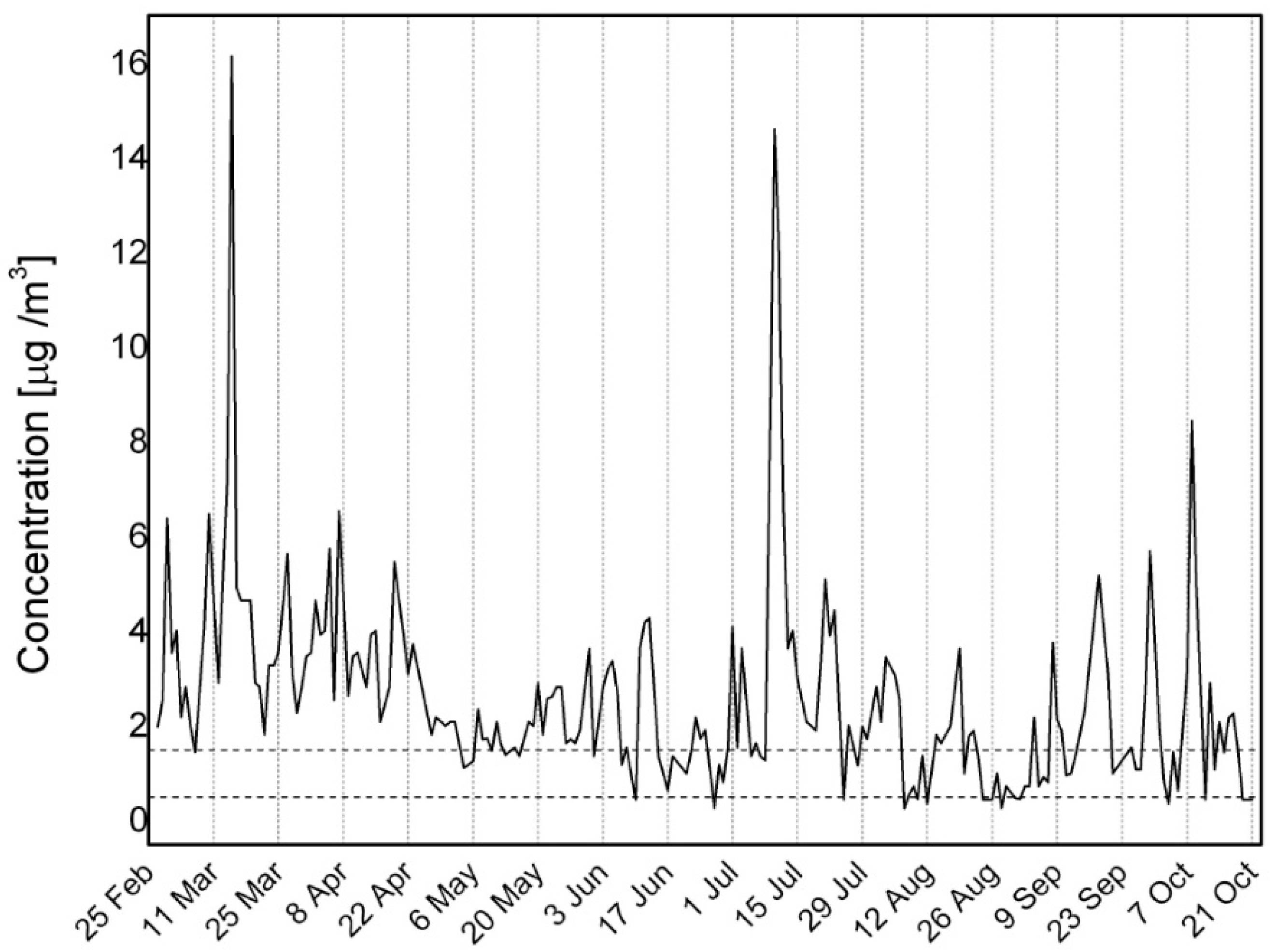


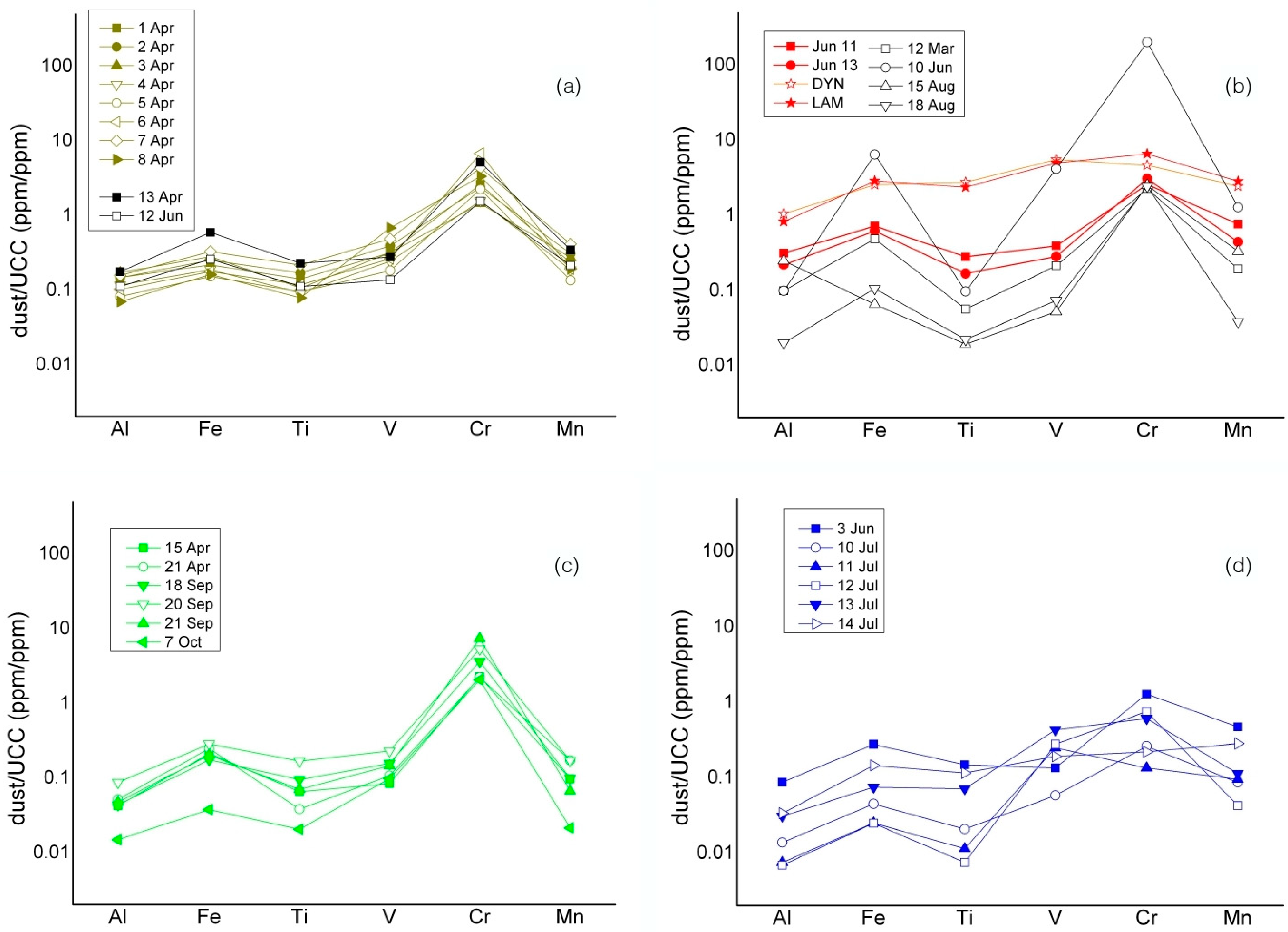

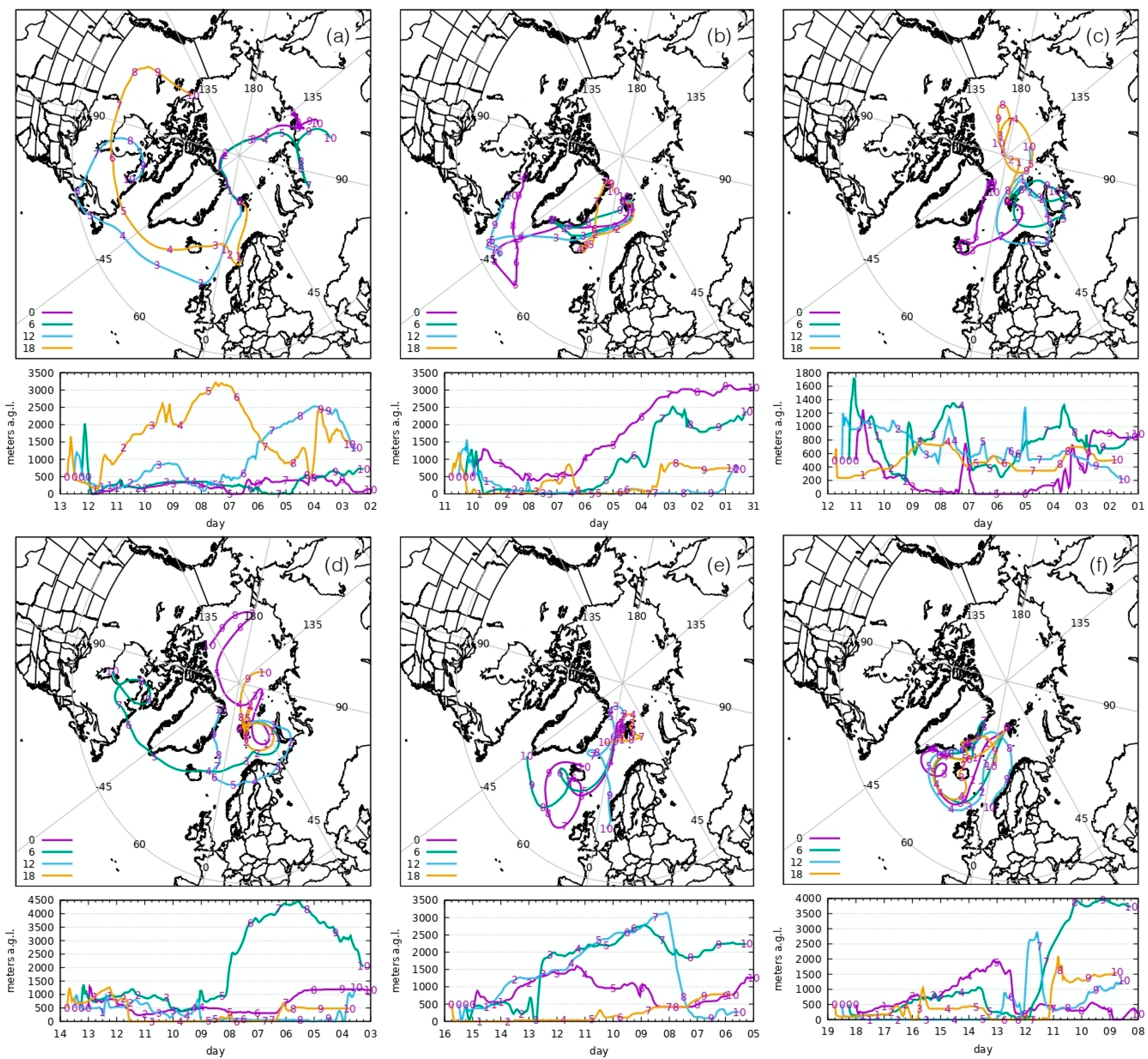
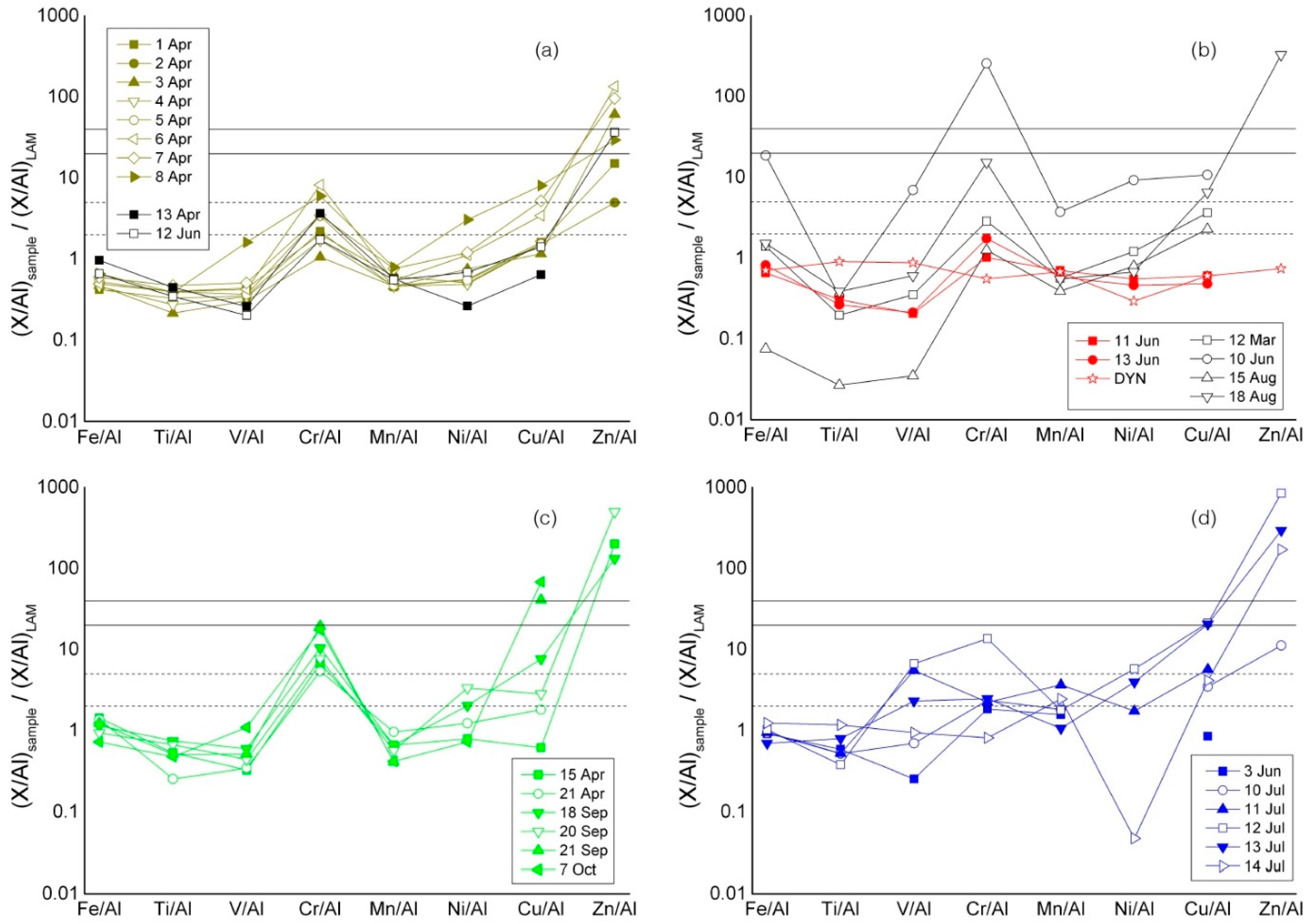
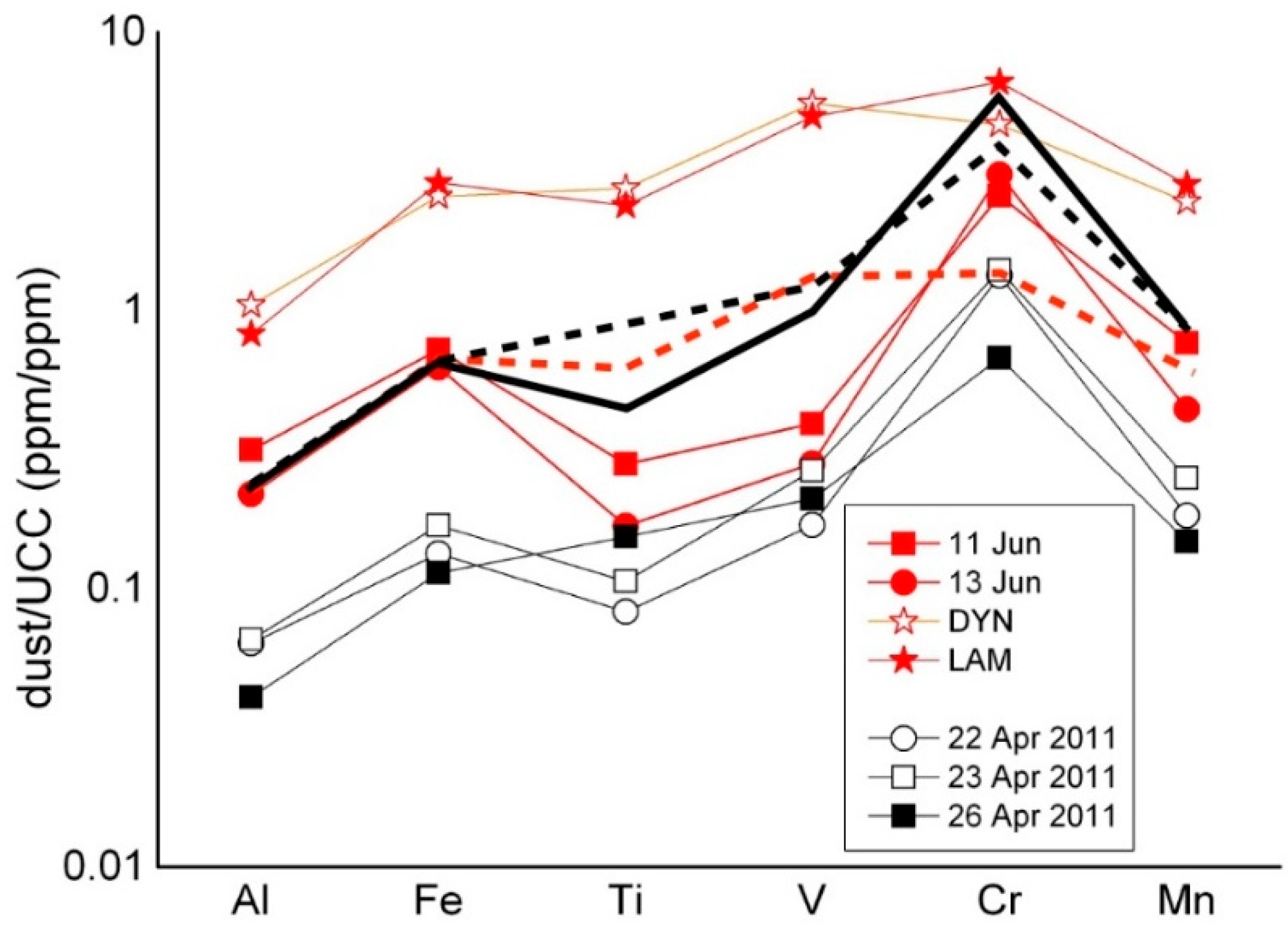
| Date | Al | Fe | Ti | V | Cr | Mn | Ni | Cu | Zn | PM10 | DL ** | |
|---|---|---|---|---|---|---|---|---|---|---|---|---|
| Eurasia | 01/04/15 | 44.64 | 27.05 | 1.81 | 0.07 | 0.33 | 0.49 | 0.07 | 0.11 | 1.03 | 3.56 | 2.06 |
| 02/04/15 | 57.68 | 40.99 | 2.83 | 0.11 | 0.39 | 0.86 | 0.08 | 0.13 | 0.44 | 4.66 | 3.16 | |
| 03/04/15 | 56.80 | 38.61 | 1.51 | 0.07 | 0.20 | 0.64 | 0.12 | 0.10 | 5.29 | 3.93 | 2.43 | |
| 04/04/15 | 39.56 | 26.33 | 1.33 | 0.06 | 0.22 | 0.45 | 0.06 | 0.09 | Bdl * | 4.02 | 2.52 | |
| 05/04/15 | 40.08 | 30.49 | 1.96 | 0.06 | 0.45 | 0.46 | 0.06 | 0.09 | bdl | 5.75 | 4.25 | |
| 06/04/15 | 22.17 | 15.82 | 1.08 | 0.04 | 0.61 | 0.29 | 0.07 | 0.11 | 4.53 | 2.56 | 1.56 | |
| 07/04/15 | 87.08 | 75.11 | 5.06 | 0.19 | 1.00 | 1.62 | 0.30 | 0.68 | 12.74 | 6.55 | 5.05 | |
| 08/04/15 | 28.11 | 26.83 | 1.35 | 0.19 | 0.56 | 0.54 | 0.25 | 0.34 | 1.26 | 4.75 | 3.25 | |
| 13/04/15 | 42.15 | 58.78 | 2.32 | 0.05 | 0.51 | 0.58 | 0.03 | 0.04 | bdl | 2.83 | 1.33 | |
| 12/06/15 | 39.70 | 37.89 | 1.69 | 0.03 | 0.23 | 0.54 | 0.08 | 0.08 | 2.22 | 4.20 | 3.70 | |
| Iceland | 12/03/15 | 24.55 | 49.71 | 0.59 | 0.04 | 0.23 | 0.34 | 0.09 | 0.13 | bdl | 2.92 | 1.42 |
| 10/06/15 | 3.80 | 102.45 | 0.16 | 0.11 | 3.24 | 0.35 | 0.10 | 0.06 | bdl | 0.45 | −0.05 | |
| 11/06/15 | 97.23 | 92.32 | 3.69 | 0.09 | 0.33 | 1.67 | 0.15 | 0.09 | bdl | 3.65 | 3.15 | |
| 13/06/15 | 79.48 | 93.65 | 2.59 | 0.07 | 0.46 | 1.13 | 0.11 | 0.06 | bdl | 4.29 | 3.79 | |
| 15/08/15 | 34.29 | 3.74 | 0.11 | 0.01 | 0.14 | 0.33 | 0.08 | 0.12 | bdl | 1.64 | 1.14 | |
| 18/08/15 | 4.77 | 10.50 | 0.23 | 0.01 | 0.24 | 0.06 | 0.01 | 0.05 | 2.39 | 2.82 | 2.32 | |
| Greenland | 15/04/15 | 14.42 | 29.84 | 0.94 | 0.02 | 0.32 | 0.23 | 0.03 | 0.01 | 4.42 | 4.02 | 2.52 |
| 21/04/15 | 17.13 | 34.00 | 0.54 | 0.03 | 0.31 | 0.40 | 0.06 | 0.05 | bdl | 3.93 | 2.43 | |
| 18/09/15 | 19.12 | 31.67 | 1.76 | 0.05 | 0.66 | 0.31 | 0.11 | 0.22 | 3.87 | 5.18 | 4.68 | |
| 20/09/15 | 22.70 | 30.73 | 1.87 | 0.04 | 0.58 | 0.32 | 0.22 | 0.09 | 17.30 | 3.09 | 2.59 | |
| 21/09/15 | 4.00 | 7.08 | 0.25 | 0.01 | 0.26 | 0.04 | bdl | 0.24 | bdl | 1.00 | 0.50 | |
| 07/10/15 | 3.99 | 4.17 | 0.23 | 0.02 | 0.23 | 0.04 | 0.01 | 0.40 | bdl | 3.18 | 2.68 | |
| Alaska | 03/06/15 | 20.77 | 27.35 | 1.50 | 0.02 | 0.13 | 0.80 | bdl | 0.03 | bdl | 2.83 | 1.33 |
| 10/07/15 | 17.03 | 22.96 | 1.09 | 0.05 | 0.13 | 0.76 | bdl | 0.09 | 0.29 | 14.62 | 14.12 | |
| 11/07/15 | 7.83 | 10.71 | 0.50 | 0.18 | 0.06 | 0.70 | 0.04 | 0.07 | bdl | 12.34 | 11.84 | |
| 12/07/15 | 3.88 | 5.75 | 0.18 | 0.11 | 0.18 | 0.17 | 0.06 | 0.12 | 5.02 | 6.67 | 6.17 | |
| 13/07/15 | 9.49 | 9.53 | 0.93 | 0.09 | 0.08 | 0.25 | 0.11 | 0.29 | 4.24 | 3.65 | 3.15 | |
| 14/07/15 | 11.44 | 20.38 | 1.66 | 0.05 | 0.03 | 0.68 | 0.00 | 0.07 | 2.97 | 4.02 | 3.52 | |
| Avg. | 11.6 | 14.5 | 0.64 | 0.02 | 0.22 | 0.19 | 0.09 | 0.09 | 4.17 | 2.60 | 1.75 | |
| RSD (%) | 120 | 180 | 270 | 130 | 150 | 140 | 150 | 200 | 110 | 81 | 115 | |
| VD # | 181 | 183 | 182 | 168 | 180 | 180 | 182 | 165 | 86 | 196 | 196 |
| Source Region | Elements | Daily Dust Events |
|---|---|---|
| Eurasia | Al, Fe, Mn, Ti, Cr and V | 1–8 April; 13 April; 12 June |
| Iceland | Fe, Cr and V | 12 March; 10–11 June; 13 June; 15 August; 18 August |
| Greenland | Fe, Cr and Ti | 15 April; 21 April; 18 September; 20–21 September; 7 October |
| Alaska | Mn and V | 3 June; 10–14 July |
Publisher’s Note: MDPI stays neutral with regard to jurisdictional claims in published maps and institutional affiliations. |
© 2021 by the authors. Licensee MDPI, Basel, Switzerland. This article is an open access article distributed under the terms and conditions of the Creative Commons Attribution (CC BY) license (http://creativecommons.org/licenses/by/4.0/).
Share and Cite
Crocchianti, S.; Moroni, B.; Waldhauserová, P.D.; Becagli, S.; Severi, M.; Traversi, R.; Cappelletti, D. Potential Source Contribution Function Analysis of High Latitude Dust Sources over the Arctic: Preliminary Results and Prospects. Atmosphere 2021, 12, 347. https://doi.org/10.3390/atmos12030347
Crocchianti S, Moroni B, Waldhauserová PD, Becagli S, Severi M, Traversi R, Cappelletti D. Potential Source Contribution Function Analysis of High Latitude Dust Sources over the Arctic: Preliminary Results and Prospects. Atmosphere. 2021; 12(3):347. https://doi.org/10.3390/atmos12030347
Chicago/Turabian StyleCrocchianti, Stefano, Beatrice Moroni, Pavla Dagsson Waldhauserová, Silvia Becagli, Mirko Severi, Rita Traversi, and David Cappelletti. 2021. "Potential Source Contribution Function Analysis of High Latitude Dust Sources over the Arctic: Preliminary Results and Prospects" Atmosphere 12, no. 3: 347. https://doi.org/10.3390/atmos12030347
APA StyleCrocchianti, S., Moroni, B., Waldhauserová, P. D., Becagli, S., Severi, M., Traversi, R., & Cappelletti, D. (2021). Potential Source Contribution Function Analysis of High Latitude Dust Sources over the Arctic: Preliminary Results and Prospects. Atmosphere, 12(3), 347. https://doi.org/10.3390/atmos12030347










